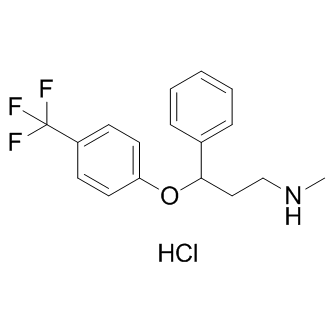| Cas No.: | 56296-78-7 |
| Chemical Name: | Fluoxetine HCl |
| Synonyms: | Fluoxetine, Prozac, Sarafem, Fluoxetine, Animex-On, Fluoxetin, Pulvules, Eufor, Portal |
| SMILES: | Cl.CNCCC(C1=CC=CC=C1)OC1=CC=C(C(F)(F)F)C=C1 |
| Formula: | C17H19ClF3NO |
| M.Wt: | 345.79 |
| Purity: | >98% |
| Sotrage: | 2 years -20°C Powder, 2 weeks 4°C in DMSO, 6 months -80°C in DMSO |
| Description: | Fluoxetine HCl is an antidepressant of the selective serotonin reuptake inhibitor (SSRI) class.Fluoxetine HCl, a specific inhibitor of serotonin re-uptake in brain, are less sensitive to electroshock. Fluoxetine HCl antagonizes the hyperalgesia following injections of p-chlorophenylalanine and potentiates morphine analgesia. Naloxone blocks the analgesia following morphine, but has no effect on Fluoxetine HCl-induced analgesia. Brain serotonin neurons may, at least in part, mediate analgesia. Administration of fluoxetine (10 mg/kg, i.p.) alone also decreased the number of spontaneously active serotonergic neurons. However, when administered following fluoxetine, pindolol significantly attenuated, but did not block completely, the inhibitory effects of fluoxetine on the number of spontaneously active serotonergic neurons. These results indicate that pindolol can attenuate the effects of fluoxetine on the firing of serotonergic neurons. These results may help explain the varying efficacy of pindolol in clinical trials with SSRIs. |
| In Vivo: | Fluoxetine treatment also reverses the deficit in escape latency observed in animals exposed to inescapable shock in adult male Sprague-Dawley rats[1]. Fluoxetine (5 mg/kg) alone increases cell proliferation in the dentate gyrus. Coadministration (fluoxetine 5 mg/kg + olanzapine) also significantly increases the number of BrdU-positive cells compared with the control group[2]. Fluoxetine combined with Olanzapine produces robust, sustained increases of extracellular levels of dopamine ([DA](ex)) and norepinephrine ([NE](ex)) up to 361% and 272% of the baseline, respectively, which are significantly greater than either drug alone[5]. |
| In Vitro: | Fluoxetine blocks the downregulation of cell proliferation resulting from inescapable shock (IS) of hippocampal cell[1]. Fluoxetine increases the number of newborn cells in the dentate gyrus of the hippocampus of adult rat. Fluoxetine also increases the number of proliferating cells in the prelimbic cortex[2]. Fluoxetine accelerates the maturation of immature neurons. Fluoxetine enhances neurogenesis-dependent long-term potentiation (LTP) in the dentate gyrus[3]. Fluoxetine, but not citalopram, fluvoxamine, paroxetine and sertraline, increases norepinephrine and dopamine extracellular levels in prefrontal cortex. Fluoxetine produces robust and sustained increases in extracellular concentrations of norepinephrine and dopamine after acute systemic administration[4]. |
| Animal Administration: | Male Sprague-Dawley rats weighing 250-300 g are housed under a 12-hour light/12-hour dark cycle (lights on at 7:00 am, lights off at 7:00 pm) and at constant temperature (25°C) and humidity and allowed free access to food and water. For chronic drug treatments, rats are administered fluoxetine (5 mg/kg/day) or saline by intraperitoneal (IP) injection once daily and olanzapine or vehicle in the drinking water for 21 days (vehicle-treated control, fluoxetine, and olanzapine alone) plus the combination of fluoxetine and olanzapine. For combination treatment, olanzapine is chosen because fluoxetine is known to interfere with the metabolism of olanzapine and raise the blood levels by up to 4-6 times. Olanzapine is dissolved in hydrochloric acid (HCl), then adjusted back to pH 6 with 1 N sodium hydroxide to make the stock solution of 3 mg/mL concentration. The same amount of vehicle solution is added to the water for the control animals. Fluid intake is measured three times per week, and drinking bottles are replenwashed with fresh drug solution. There are no differences in fluid intake among the treatment groups. For subchronic treatment, drugs are administered exactly the same way but for a total period of 7 days. |
| References: | [1]. Malberg JE, et al. Cell proliferation in adult hippocampus is decreased by inescapable stress: reversal by fluoxetine treatment. Neuropsychopharmacology. 2003 Sep;28(9):1562-71 [2]. Kodama M, et al. Chronic olanzapine or fluoxetine administration increases cell proliferation in hippocampus and prefrontal cortex of adult rat. Biol Psychiatry. 2004 Oct 15;56(8):570-80. [3]. Wang JW, et al. Chronic fluoxetine stimulates maturation and synaptic plasticity of adult-born hippocampal granule cells. J Neurosci. 2008 Feb 6;28(6):1374-84. [4]. Bymaster FP, et al. Fluoxetine, but not other selective serotonin uptake inhibitors, increases norepinephrine and dopamine extracellular levels in prefrontal cortex. Psychopharmacology (Berl). 2002 Apr;160(4):353-61 [5]. Zhang W, et al. Synergistic effects of olanzapine and other antipsychotic agents in combination with fluoxetine on norepinephrine and dopamine release in rat prefrontal cortex. Neuropsychopharmacology. 2000 Sep;23(3):250-62. [6]. Su WJ, et al. Antidiabetic drug glyburide modulates depressive-like behavior comorbid with insulin resistance. J Neuroinflammation. 2017 Oct 30;14(1):210. |

 DC Chemicals' products qualify for U.S. tariff exemptions. We guarantee no price increases due to customs duties and maintain stable supply, continuing to deliver reliable research solutions to our American clients.
DC Chemicals' products qualify for U.S. tariff exemptions. We guarantee no price increases due to customs duties and maintain stable supply, continuing to deliver reliable research solutions to our American clients.





















